



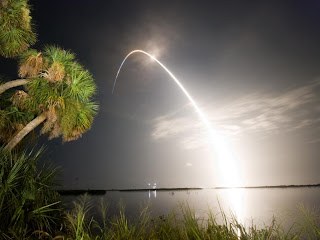

A discovery about the moon made in the 1960s is helping researchers unlock secrets about Earth's ocean today.
By applying a method of calculating gravity that was first developed for the moon to data from NASA's Gravity Recovery and Climate Experiment, known as Grace, JPL researchers have found a way to measure the pressure at the bottom of the ocean. Just as knowing atmospheric pressure allows meteorologists to predict winds and weather patterns, measurements of ocean bottom pressure provide oceanographers with fundamental information about currents and global ocean circulation. They also hold clues to questions about sea level and climate.
"Oceanographers have been measuring ocean bottom pressure for a long time, but the measurements have been limited to a few spots in a huge ocean for short periods of time," says JPL oceanographer Victor Zlotnicki.
Launched in 2002, the twin Grace satellites map Earth's gravity field from orbit 500 kilometers (310 miles) above the surface. They respond to how mass is distributed in the Earth and on Earth's surface -the greater the mass in a given area, the stronger the pull of gravity from that area.
The pressure at the bottom of the ocean is determined by the amount of mass above it. "Ocean bottom pressure is the sum of the weight of the whole atmosphere and the whole ocean," says Zlotnicki. "When winds move water on the surface, ocean bottom pressure changes. When glaciers melt and add water to the ocean, the ocean's mass increases and bottom pressure increases, either at one place or globally."
"Measuring ocean bottom pressure was one of the things we said we wanted to do from the very beginning of the mission," says Grace project scientist Michael Watkins, "but it has been a challenge. The signal is very small and hard to detect."
Gravity changes over the ocean are miniscule compared to those over land. The ocean is a fluid. It yields to pressure and spreads the effect over a vast area. Nothing in the ocean gives as big a gravity signal as a flooding Amazon River or melting glaciers in Greenland or Alaska, changes that Grace can measure fairly easily, says Watkins. "Those hydrology signals are huge in comparison," he says.
However, as the mission progressed, Watkins explains, the science team has found better ways to process Grace data. And by turning to a technique developed for the lunar world, Grace researchers are getting the precise measurements of ocean bottom pressure they were hoping for.
From the moon to the ocean bottom
In the days leading up to the Apollo missions, JPL scientists discovered that certain areas of the moon had higher concentrations of mass than others. The result of these "mass concentrations" was marked differences in the moon's gravity field.
The researchers then devised a new way to calculate the gravity field called a "mascon" (for mass concentration) solution. Mascon solutions break the gravity field into small, individual regions. The more traditional ways of computing gravity, often called harmonic solutions, smooth everything together and calculate gravity for a whole large area or body.
Recently scientists have begun developing mascon solutions for Grace data for use in a variety of studies, and they are revealing fascinating new details about Earth's gravity field. These mascon solutions are also proving to be a key to Grace's ability to measure ocean bottom pressure.
"Some of the very best harmonic solutions show some bottom pressure signals, but the mascon solutions appear to do a better job and provide much higher resolution," says Watkins. "Using a mascon solution with Grace data is a way of weighing each little piece of the ocean," he says. The result is a new view of the gravity field - one that reveals sharp contrasts in gravity precise enough to calculate variations in ocean bottom pressure.
A large field experiment off the coast of Japan provided an unusual and welcomed opportunity to put Grace mascon estimates of ocean bottom pressure to the test. There are few places in the ocean where there are enough data on ocean bottom pressure to validate the satellite's observations.
Oceanographer Jae-Hun Park and his colleagues at the University of Rhode Island compared the Grace measurements with data collected by a large array of pressure-reading instruments stationed on the ocean bottom as part of the Kuroshio Extension System Study. This two-year observational program to study deep ocean currents and fronts ran from 2004 to 2006.
"Our site covered a very wide area of 600 by 600 kilometers (370 miles) with 43 available bottom pressure sensors," says Park. He and his colleagues found that while some of the individual sensors had very high correlations with Grace measurements, others were very low. "These low correlations were small-scale eddies that Grace cannot catch," explains Park. Grace's resolution is about 200 kilometers (125 miles).
However, when they compared the spatially averaged monthly mean ocean bottom pressure measured by the ocean sensors with the latest JPL Grace mascon solution for the center of the array, "we found a high correlation between the Grace measurements and our in-situ measurements," says Park. "This experiment gave us the opportunity to validate the Grace data." The results of the study appeared last year in Geophysical Research Letters.
Grace's new ability to detect small changes in ocean mass - reflected in ocean bottom pressure - will help scientists answer ongoing questions about sea level and climate change. It will help clarify, for example, just how much of sea level change is due to differences in ocean mass, the result of evaporation, precipitation, melting land ice, or river run-off and how much is due to temperature and salinity.
"Now, for the first time with these new mascon solutions," say Zlotnicki, "Grace will allow us to measure changes in ocean bottom pressure globally for long periods of time. This is a new tool for oceanography."
 NASA's Mars Reconnaissance Orbiter put itself into a safe mode Wednesday morning, Aug. 26, for the fourth time this year, while maintaining spacecraft health and communications. While in safe mode, the spacecraft has limited activities pending further instructions from ground controllers.
NASA's Mars Reconnaissance Orbiter put itself into a safe mode Wednesday morning, Aug. 26, for the fourth time this year, while maintaining spacecraft health and communications. While in safe mode, the spacecraft has limited activities pending further instructions from ground controllers. Testing at NASA's Jet Propulsion Laboratory in August 2009 is assessing possible maneuvers that the Mars rover Spirit might use for escaping from a patch of soft soil where it is embedded at a Martian site called "Troy".
Testing at NASA's Jet Propulsion Laboratory in August 2009 is assessing possible maneuvers that the Mars rover Spirit might use for escaping from a patch of soft soil where it is embedded at a Martian site called "Troy".The testing of the liquid hydrogen fill and drain valve in shuttle Discovery’s main propulsion system is complete. The valve and its position indicator both operated normally during yesterday’s testing. And all leak checks were within specification.
The evaluation of the low-level hydrogen leak detected in a tail service mast on the mobile launcher platform on Launch Pad 39A following Tuesday's launch scrub is complete, and no leaks were detected.
All the test data will be brought to the mission management team for review at the noon EDT meeting. Mission managers also will meet at 2:15 p.m. to give the “Go - No Go” for tanking.
Discovery's seven astronauts are sleeping and will wake up for their launch day preps at 1:30 p.m. The launch countdown is to resume at the T-11 hour point at 8:57 a.m. this morning.
If Discovery gets the “Go”, tanking commentary on NASA TV will begin at 2:45 p.m. and fueling operations will start at approximately 3 p.m. Launch commentary will begin tonight at 7 p.m.
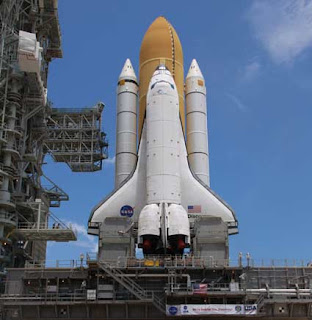 Discovery Readies for Station Resupply Flight
Discovery Readies for Station Resupply Flight The second rover, called the Surface System Testbed Lite (far right) is lighter weight than the primary engineering test rover, called the Surface System Testbed (left foreground). The lighter version does not carry a science payload and robotic arm, as Spirit, Opportunity and the Surface System Testbed do.
The second rover, called the Surface System Testbed Lite (far right) is lighter weight than the primary engineering test rover, called the Surface System Testbed (left foreground). The lighter version does not carry a science payload and robotic arm, as Spirit, Opportunity and the Surface System Testbed do. The load measurement system on ATK's test stand which is attached to the thrust block. (ATK)
The load measurement system on ATK's test stand which is attached to the thrust block. (ATK) Newly installed mid-span support for the Ares I five-segment solid rocket motor. (ATK)
Newly installed mid-span support for the Ares I five-segment solid rocket motor. (ATK)


In 2003, when Mars neared opposition — its closest approach to Earth in its 22-month orbit around the sun — it was less than 56 million kilometers (less than 35 million miles) away. This was the closest it had been in over 50,000 years. The e-mail that circulated back then said that Mars, when viewed through a telescope magnified 75 times, would look as large as the moon does with the unaided eye. Even back in 2003, to the unaided eye, Mars looked like a reddish star in the sky to our eyes, and through a backyard telescope it looked like a small disc with some dark markings and maybe a hint of its polar ice cap. Without magnification, it never looked as large as the moon, even back in 2003!
as the moon does with the unaided eye. Even back in 2003, to the unaided eye, Mars looked like a reddish star in the sky to our eyes, and through a backyard telescope it looked like a small disc with some dark markings and maybe a hint of its polar ice cap. Without magnification, it never looked as large as the moon, even back in 2003!
No. The moon is one-quarter the size of Earth and is relatively close — only about 384,000 kilometers (about 239, 000 miles) away. On the other hand, Mars is one-half the size of Earth and it orbits the sun 1-1/2 times farther out than Earth’s orbit. The closest it ever gets to Earth is at opposition every 26 months. The next opposition is in January 2010.
At that time, Mars will be 98 million kilometers (61 million miles) from Earth, almost twice as far as in 2003. So from that distance, Mars could never look the same as our moon.
Mars rises in the east at about 1:30 a.m. this month and is best seen closer to dawn. It is a ruddy star-like object about the same brightness as the brightest stars you’ll see. Look for Mars above the constellation Orion in the pre-dawn sky. The moon is close by on the mornings of August 15 and 16. The brighter object in the sky below and left of Mars is Venus!
If you get up before sunrise on August 15 and 16, you can see the waning crescent moon pass by Mars. The next two mornings, August 17 and 18, you’ll see the moon pass by Venus, which is the bright object below Mars in the morning sky. This will be a great time to compare the sizes of the moon and Mars for yourself!
Most certainly! But next year, you’ll be armed with facts, and perhaps you will have looked at the red planet for yourself and will know what to expect. And you will know exactly where to put that email. In the trash!
Scientists using a camera designed and operated at Arizona State University's Mars Space Flight Facility have discovered the first evidence for deposits of chloride minerals - salts - in numerous places on Mars. These deposits, say the scientists, show where water was once abundant and may also provide evidence for the existence of former Martian life.
minerals - salts - in numerous places on Mars. These deposits, say the scientists, show where water was once abundant and may also provide evidence for the existence of former Martian life.
A team of scientists led by Mikki Osterloo, of the University of Hawaii, used data from the Thermal Emission Imaging System (THEMIS) on NASA's Mars Odyssey orbiter to discover and map the Martian chloride deposits. The Jet Propulsion Laboratory in Pasadena, Calif., manages the Mars Odyssey mission for NASA's Science Mission Directorate.
Developed at Arizona State University, THEMIS is a multi-wavelength camera that takes images in five visual bands and 10 infrared ones. At infrared wavelengths, the smallest details THEMIS can see on the Martian surface are 330 feet (100 meters) wide.
The scientists found about 200 individual places in the Martian southern hemisphere that show spectral characteristics consistent with chloride minerals. These salt deposits occur in the middle to low latitudes all around the planet within ancient, heavily cratered terrain. The team's report appears in the March 21, 2008 issue of the scientific journal Science.
Besides Osterloo, the team includes Philip Christensen, Joshua Bandfield, and Alice Baldridge of Arizona State University's Mars Space Flight Facility; Victoria Hamilton and Scott Anderson of the University of Hawaii; Timothy Glotch of Stony Brook University; and Livio Tornabene of the University of Arizona.
Osterloo found the sites by looking through thousands of THEMIS images processed to reveal, in false colors, compositional differences on the Martian surface. As she explains, "I started noting these sites because they showed up bright blue in one set of images, green in a second set, and yellow-orange in a third."
Says team member Christensen, "THEMIS gives us a good look at the thermal infrared, the best part of the spectrum for identifying salt minerals by remote sensing from orbit."
When plotted on a global map of Mars, the chloride sites appeared only in the southern highlands, the most ancient rocks on Mars.
Lay of the Land
Christensen goes on to characterize the sites' geological setting. "Many of the deposits lie in basins with channels leading into them," he says. "This is the kind of feature, like salt-pan deposits on Earth, that's consistent with water flowing in over a long time."
Christensen, a Regents' Professor of Geological Sciences at ASU's School of Earth and Space Exploration in the College of Liberal Arts and Sciences, designed THEMIS and is the instrument's principal investigator.
Osterloo notes, "The deposits range in area from about one square kilometer to about 25 square kilometers," or about 0.4 square mile to about 10 square miles. She adds, "Because the deposits appear to be disconnected from each other, we don't think they all came from one big, global body of surface water." Instead, she says, "They could come from groundwater reaching the surface in low spots. The water would evaporate and leave mineral deposits, which build up over years."
The scientists think the salt deposits formed mostly in the middle to late Noachian epoch, a time that researchers have dated to about 3.9 to 3.5 billion years ago. Several lines of evidence suggest that Mars then had intermittent periods of substantially wetter and warmer conditions than today's dry, frigid climate.
Looking for Life
Up to now, scientists looking for evidence of past life on Mars have focu sed mainly on a handful of places that show evidence of clay or sulfate minerals. The reasoning is that clays indicate weathering by water and that sulfates may form by water evaporation.
sed mainly on a handful of places that show evidence of clay or sulfate minerals. The reasoning is that clays indicate weathering by water and that sulfates may form by water evaporation.
The new research, however, suggests an alternative mineral target to explore for biological remains. Says Christensen, "By their nature, salt deposits point to a lot of water, which could potentially remain standing in pools as it evaporates." That's crucial, he says. "For life, it's all about a habitat that endures for some time."
There may also be a concentrating effect, Christensen adds. "The deposits lie in what are probably sedimentary basins. If you look upstream, you might find only a trace of organic materials because they're thinly dispersed." But over a long period of time, he explains, "The water flowing into a basin can concentrate the organic materials and they could be well preserved in the salt."
Whether or not the Red Planet ever had life is the biggest scientific question driving Mars research. On Earth, salt has proven remarkably good at preserving organic material. For example, bacteria have been revived in the laboratory after being preserved in salt deposits for millions of years.
NASA is currently studying potential landing sites for its Mars Science Laboratory (MSL), a new-generation rover due for launch in fall 2009. Sites featuring clay deposits number heavily in the short-list of candidate places to send the rover.
Christensen says, "Scientists have studied Martian clay mineral sites for years now, and it's natural they should be considered as targets for the Mars Science Laboratory rover. However, the discovery of chloride minerals in topographic basins within the oldest rocks on Mars should also be considered as an alternative mineralogy for MSL or future rovers to explore."
"This discovery demonstrates the continuing value of the Odyssey science mission, now entering its seventh year," says Jeffrey Plaut, Odyssey project scientist at the Jet Propulsion Laboratory. "The more we look at Mars, the more fascinating a place it becomes."
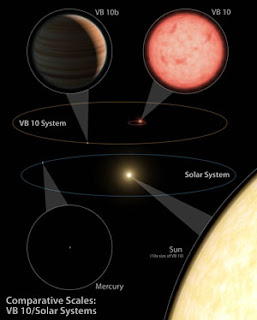
"VB10 is the lowest-mass star we know of and is about as low-mass as a star can be," says Laughlin, co-writer of the book "The Five Ages of the Universe," which deals with the far-off future of our Milky Way galaxy. "Stars that small are very stingy with their energy production and burn so slowly that VB10 will be shining for the next 10 trillion years."
By the time VB10 runs out of fuel, Laughlin explains, the galaxy will have become a very different place. "Most of the other stars in the galaxy will have burned out," including our own sun, Laughlin says. "Stars like VB10 will be all that's left shining."
Over its lengthy lifetime, VB10 and its companion planet will witness spectacular changes in the neighborhood. "The Milky Way and Andromeda are on track to collide in about 5 billion years," Laughlin says. "Because stars are all so far apart --picture grains of sand separated by miles of empty space --there won't be any stellar collisions. But the gas clouds in each galaxy will smack into each other and create an intense burst of star formation."
This period, in which the galactic average of one new star a year will increase to between 10 and 50, will be, "the last baby boom" of the new combination galaxy, Laughlin says. As star formation decreases and old stars burn out, "the backdrop will slowly fade away, leaving behind stars that are 'built to last' like VB10," he says.
And as if 10 trillion years weren't a long enough lifespan, Laughlin explains that the gigantic planet orbiting VB10, which is 6.4 times the size of Jupiter, will eventually serve, quite literally, as the star's "extra gas tank."
"VB10 b's orbit will slowly tighten, and the planet will eventually merge with its star," Laughlin says. "The planet's gas will be a shot of fresh hydrogen to VB10 and should give it enough fuel to burn another 100 billion years -- basically forever."
VB10 was the first system to be discovered using astrometry, and Laughlin is hopeful that future astrometric missions, such as NASA's SIM Lite, will be able to find many similar systems. "SIM will be able to find a ton of objects like this," he says.
With their incredible endurance and "extra gas tank" planets, stars like VB10 ensure that, several quadrillion years from now and long after most other objects have faded into darkness, there will still be stars twinkling in the sky.
NASA rocket scientists often perform feasibility studies which examine a spacecraft design based on the laws of science (physics, mechanics, chemistry, etc.). Scientists, also, use spacecraft design conventions known as "rules of thumb" to determine whether a spacecraft concept has merit. A basic engineering education includes an introductory course in college physics. The same material is covered in less depth in high school physics as well as grade school science. A student can learn much about the laws of science by attempting an informal feasibility study on a spacecraft from a science fiction comic book, a sci-fi magazine cover, or a STAR WARS or STAR TREK video. Listed below are some of the laws of science often violated by artists and authors. Included are descriptive examples of errors often revealed by such feasibility studies.
One of the best ways of determining what is scientifically reasonable is to imagine yourself inside the subject vehicle. Next, try to compare the vehicle to driving a car, piloting an airplane, or even riding a bicycle. These vehicles must obey the laws of science. Each requires a means of steering, an engine or motor for transporting the vehicle, and a way of positioning the driver or passengers in order for them to control and ride inside the vehicle. When something does not seem correct about the science fiction art, try to classify which of the items below may be violated by the drawing.
For example, some artists fail to draw a viewing window for the pilot of a spacecraft to see where the craft is going. Others, leave out a hatch for the astronaut to enter or leave the vehicle. Can you imagine a car without doors? Below is a list of some of the most obvious abuses of the laws of science in science fiction art.
EINSTEIN'S THEORY OF RELATIVITY: The fastest speed possible is the speed of light which is approximately 186,000 miles per second. This is a part of Einstein's theory. In certain conditions, it can be considered as a law of science. Einstein's equation states that the mass of an object times the speed of light squared equals the energy contained within an object. Einstein's equation demonstrates that when an object approaches the speed of light its mass increases toward infinity. The speed of light is a limiting speed of starships. Einstein's theory also deals with time. According to Einstein, as a starship's speed approaches the speed of light, the passage of time slows with respect to the launch site where the mission began. Those on board the starship grow older more slowly than those remaining on the home planet. Authors writing about trips to the stars often violate Einstein's theory when they speak of faster than light propulsion, warp drive, alternate universes, and other means of placing the setting of their story at light year distances from Earth.
CENTRIPETAL FORCE: Centripetal force is the force that causes a mass to travel in an arc or circular orbit. It is equal to the object's mass times its tangential velocity squared divided by the radius of the arc or circular path. The "pulling away of the mass from the radius of curvature of the arc (the orbit)" is due to the inertia of the object causing it to try to move in a straight line. The pulling away is a result of Newton's First Law. (Newton's First Law: An object at rest tends to stay at rest and an object in motion tends to stay in motion with the same speed and in the same direction unless acted upon by an unbalanced force.)
THE LAW OF UNIVERSAL GRAVITATION: Every particle of matter in the universe attracts every other particle with a force proportional to the product of the masses of the particles and inversely proportional to the square of the distance between them. Newton's law of universal gravitation is often ignored in sci-fi art. To show a hovering flying saucer, suspended above a planet's surface without visible rocketry, rotating propellers or helicopter rotors is a violation of Newton's law of gravitation.
THE GAS LAW: The gas law is PV = nRT where P is the pressure of a gas on the walls of a closed container and V is the volume of the container. The constants, n and R, relate P and V to the temperature of the gas, T. Showing astronauts in the vacuum of space without pressure suits violates the gas law. Space station crew quarters must be pressurized. Exit from space vehicles requires airlocks to preserve air pressure within pressurized compartments. Opening a pressurized compartment to the vacuum of space without an airlock rapidly releases precious oxygen. Drawing such activity as a nominal procedure causing no detrimental results on the crew is a violation of the gas law.
Welcome and thank you for your interest in this exciting fellowship opportunity. The National Aeronautics and Space Administration (NASA) is proud to offer fellowships to students in their undergraduate and graduate careers.
The Aeronautics Scholarship Program (ASP) offers our nation's research leaders of tomorrow exceptional funding:
Undergraduate Students
Graduate Students
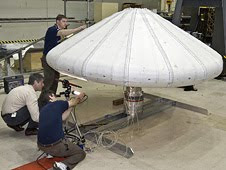
 hicles as they blaze through the atmosphere at hypersonic speeds.
hicles as they blaze through the atmosphere at hypersonic speeds.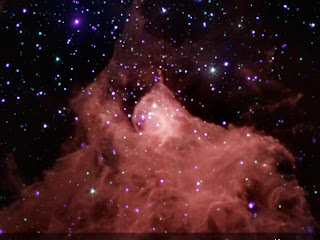

 loration vehicle arrived at the U.S. Army's White Sands Missile Range in New Mexico after a 14-hour journey from Salt Lake City. The motor will soon be fully integrated with the other system motors in preparation for the Pad Abort 1, or PA-1, flight test this fall.
loration vehicle arrived at the U.S. Army's White Sands Missile Range in New Mexico after a 14-hour journey from Salt Lake City. The motor will soon be fully integrated with the other system motors in preparation for the Pad Abort 1, or PA-1, flight test this fall. is equipped with a unique reverse flow manifold that includes four head end turn flow nozzles. The manifold is placed at the forward end of the motor. Rocket plumes exit all four nozzles at 155 degrees, instead of straight out the aft end, creating forward thrust. The reverse flow manifold, which was designed to provide the necessary plume clearance between the system and the Orion crew capsule, is the first of its kind for a high-thrust rocket motor system on a U.S. human space flight vehicle.
is equipped with a unique reverse flow manifold that includes four head end turn flow nozzles. The manifold is placed at the forward end of the motor. Rocket plumes exit all four nozzles at 155 degrees, instead of straight out the aft end, creating forward thrust. The reverse flow manifold, which was designed to provide the necessary plume clearance between the system and the Orion crew capsule, is the first of its kind for a high-thrust rocket motor system on a U.S. human space flight vehicle.